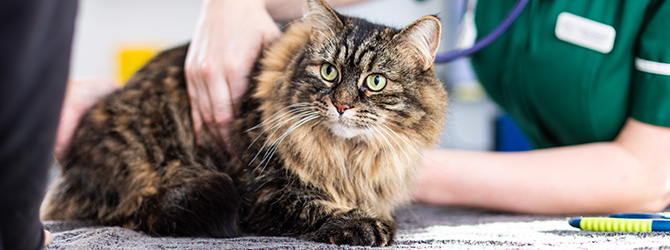Feline dermatitis: does my cat have eczema?
2 min read
First Published: 28/08/2018
Last Updated: 09/12/2022
Skin conditions are very common in cats, and there are a number of causes. One of the most common causes of skin conditions in cats is allergies – often called allergic dermatitis.
Dermatitis, or eczema, can be caused by a range of triggers, from the food your cat eats to chemicals in your home environment. Your cat may even be allergic to flea bites (yet another reason to get into a regular pest prevention routine!)
Signs and symptoms of dermatitis in cats
- Scratching
- Red bumps on the skin
- Scaly patches
- Itchiness, especially around the face and feet
- Frequent head shaking
- Thick, dark patches of skin
- Patches of hair loss
Itchy skin can be caused by many conditions, and you may want to read our article on cat allergies to find out more about the triggers and symptoms. Dermatitis in cats is slightly different.
“Dermatitis literally means inflammation of the skin and any pain, irritation or itchiness that come with it.”
Flea allergy dermatitis in cats
Flea allergy dermatitis (FAD) – sometimes called parasitic dermatitis – is the most common type of dermatitis in cats. FAD causes serious itching that’s triggered by flea saliva on the cat’s skin, tick bites or other parasites.
As always, the best treatment for fleas is prevention. Once those pesky parasites take hold of your cat and your home they’re tricky blighters to eliminate, so it’s vital to get into a regular routine of protecting your cat against fleas. Your vet will recommend the best methods of flea prevention – from spot-on liquids to flea collars or tablets
Infectious dermatitis in cats
Ringworm, fungal and yeast infections can cause all sorts of skin problems in cats, known as infectious dermatitis. Infectious dermatitis is easily passed to other cats and, in the case of ringworm, people too. Treatment may involves clipping the cat’s fur to apply suitable creams as well as any oral or topical treatments appropriate to the underlying cause
Atopic dermatitis in cats
Atopic dermatitis (AD) is a skin reaction to an allergen a cat has touched or inhaled. Causes include dust and mould spores, food or milk products, wool or nylon, and various pollens.
The cat’s skin breaks out – much like acne in us humans – and starts to itch. Scratching often breaks the skin and causes bleeding or hair loss, and can even lead to infection.
Preventing and treating cat eczema and dermatitis
It’s impossible to prevent dermatitis and eczema in cats, but treatment is usually very effective as long as you act fast. Treatment can include topical, oral and injectable medication, such as hydrocortisone or antihistamines and , where appropriate, specific treatments such as antibiotics
“Atopic dermatitis is a skin reaction to an allergen a cat has touched or inhaled. Causes include dust and mould spores, food or milk products, wool or nylon, and various pollens.”
Advice on cat dermatitis and eczema
For expert advice and treatment on cat dermatitis and eczema, contact your local vet.
Find your nearest vet using our Find a Vet page, or speak to a vet online using Online Vets.
